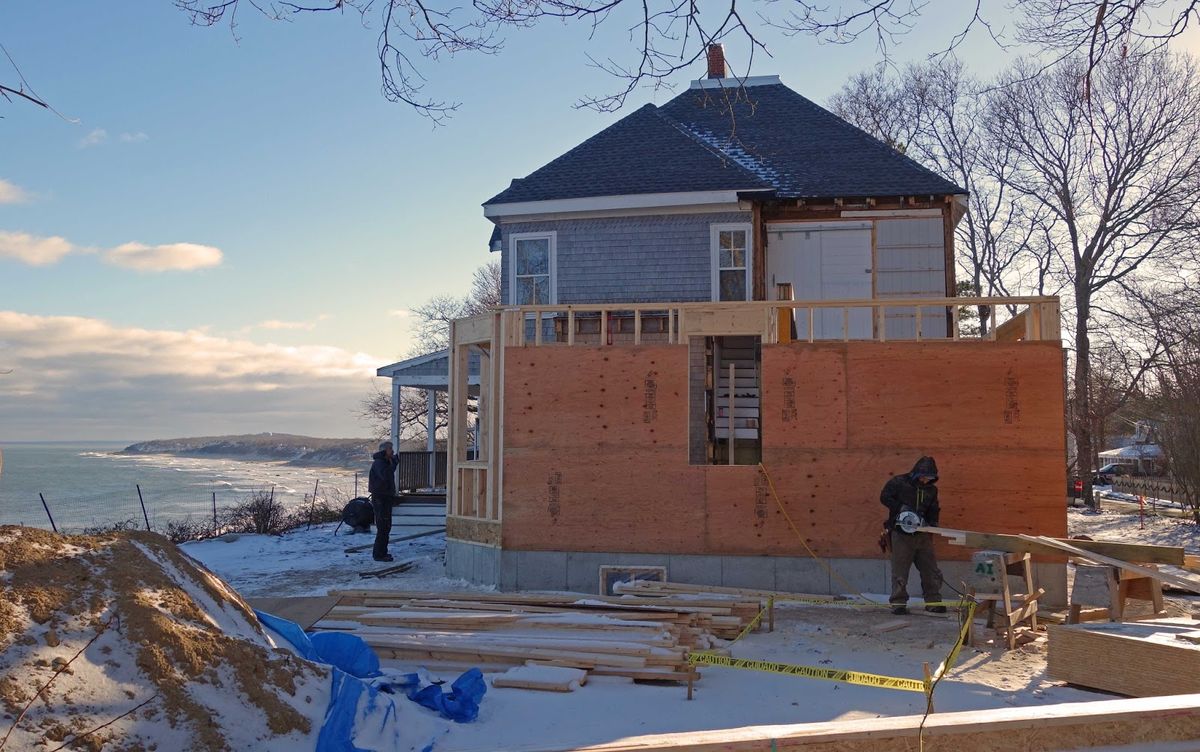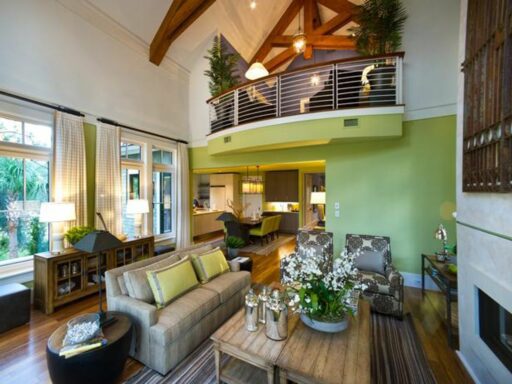The article ‘Tempe Homeowner Astonished by Contractor’s Work: A ‘Floored’ Revelation’ delves into the evolving landscape of interior design, where the past and present merge to create stunning living spaces. It highlights the resurgence of brown antique furniture, the charm of Art Deco and vintage finds, the enduring nature of Bohemian style, the reimagined Memphis design, and the mainstream adoption of antique and vintage decor. This piece illuminates the shifting preferences of homeowners and collectors, showcasing how historical pieces are being reinterpreted to fit modern aesthetics.
Key Takeaways
- Brown antique furniture is experiencing a revival, with a growing appreciation for dark wood pieces and their contribution to a well-rounded home.
- Art Deco and vintage finds from the 1980s, particularly black-lacquer cabinets and gold-mirrored tables, are in high demand, driven by a nostalgic revival.
- Bohemian (Boho) style has cemented its place as a lasting trend, with eclectic home decor and unexpected items like footstools and rugs gaining popularity.
- Memphis design is being reintegrated into contemporary spaces in a more subdued form, indicating a shift from Mid-Century Modern to a new elegance.
- The preference for antique and vintage decor is becoming the norm, with period properties and unique pieces being sought after for both personal and investment purposes.
The Resurgence of Brown Antique Furniture

A Return to Tradition in Modern Homes
In the ever-evolving world of home decor, a quiet revolution is underway. Brown antique furniture, once relegated to the shadows of modernist trends, is now experiencing a resurgence. This shift is not just about aesthetics; it’s a deeper movement towards creating spaces that feel both timeless and deeply personal.
The appeal of these pieces lies in their ability to bring warmth and character to a room. Homeowners are increasingly seeking out Georgian-inspired Victorian pieces, signaling a shift from the once prevalent white-washed modern motif. It’s a trend that’s gaining momentum, particularly among a demographic transitioning into ‘forever’ homes and seeking a sense of permanence and tradition.
The resurgence of brown antique furniture is not merely a nostalgic nod to the past; it’s a deliberate choice for those looking to infuse their homes with a sense of history and craftsmanship.
As this trend continues to grow, it’s clear that the allure of brown antique furniture is more than just a passing fancy. It’s a testament to the enduring appeal of quality and design that stands the test of time.
The Increasing Demand for Dark Wood Pieces
The allure of dark wood furniture is experiencing a renaissance among homeowners and designers alike. The intrinsic value of pieces crafted from solid, dark woods like walnut, teak, rosewood, and mahogany is now being recognized as essential to creating a well-rounded and soulful living space. Designers are reporting a significant uptick in client requests for dark wood, indicating a broader trend beyond individual preferences.
The shift towards dark wood is not just about aesthetics; it’s about crafting spaces that reflect the values and trends of the community. Dubuque homeowners, for instance, are embracing this trend by incorporating personalized construction and eco-friendly solutions into their homes.
To successfully integrate dark wood furniture without overwhelming a space, consider the following tips:
- Pair golden teak with rich dark walnut against neutral walls for definition and contrast.
- Accentuate brown furniture with lighter accents to avoid a dark and dreary look.
- Seek balance by distributing dark and light elements evenly throughout the room.
The resurgence is not limited to a particular region; it’s a movement that’s gaining traction across various demographics. Younger buyers, as they settle into their ‘forever’ homes, are increasingly drawn to the warmth and tradition that brown wood furniture offers. This trend is reflected in the rising numbers of dark wood furniture pieces being added to dealers’ inventories.
Blending the Old with the New: A Design Revolution
In the heart of this design revolution, homeowners are embracing a fusion of antique charm with contemporary flair. The trend is not just about aesthetics; it’s a reflection of a broader shift towards sustainability and individuality in home decor.
- Timeless Fusion: Vintage pieces add a layer of history and durability to modern interiors.
- Patterns Play: Introducing vintage patterns can bring a unique character to a space.
- Unique Designs: The market is replete with one-of-a-kind vintage items waiting to be rediscovered.
The blend of old and new is more than a style choice; it’s a statement of personal values and a commitment to a sustainable future.
Harold Blum, a veteran in the antique industry, notes a significant uptick in the sales of Georgian and Victorian pieces to homes that once favored a stark modern look. This shift is not isolated to the realm of antiques. Even in the world of design, where the Memphis style once reigned, there’s a movement towards more subdued, yet still vibrant, interpretations that complement rather than dominate a room.
The Allure of Art Deco and Vintage Finds

The Miami Influence: A 1980s Revival
The 1980s are making a comeback in home decor, with a particular nod to the Miami influence that defined the era’s style. This resurgence is not just about nostalgia; it’s a celebration of the boldness and vibrancy that the decade represented.
Trey’s discovery of a unique South-Deco furniture style, characterized by modular tables and Art Deco influences, reflects a growing trend among younger generations. They are scooping up vintage 1980s pieces from estate and garage sales, drawn by the ‘cool factor’ and the distinctive aesthetic of the time.
Karen Smith, a veteran in vintage resale and Miami interior design, acknowledges the radical nature of 1980s design. The Memphis Style, with its crazy colors and unique design features, may not be for everyone, but it’s gaining traction. This shift in taste is a clear departure from the previously dominant Mid-Century Modern trend, signaling a broader acceptance of the decade’s exuberant style.
The renewed interest in 1980s design is driven by a blend of nostalgia and appreciation for the era’s exuberance and optimism. As people reminisce about the past, they are increasingly drawn to the design elements that capture the spirited aesthetics of the time.
The decorative arts community has taken note of this shift, with many industry insiders like Albero attributing the trend to a longing for the past’s pizazz. The 1980s were marked by a unique blend of exuberance, optimism, and innovation, qualities that are now being sought after in contemporary home decor.
From Garage Sales to Showroom Glory
The journey from dusty garage sale finds to polished showroom pieces is a testament to the transformative power of vision and effort. Deborah Torres’ story is a prime example of how a modest budget and a keen eye can lead to a thriving vintage business. Starting with small-scale purchases, she built a collection that now graces the showrooms of Florida’s east coast.
For many, the thrill lies in the hunt. Carla Neal’s strategy of targeting older neighborhoods for garage and estate sales has paid off, unearthing treasures that have been overlooked by others. Similarly, Jeff Howard’s return to hands-on sales has seen his weekend revenue skyrocket, proving that there’s still a significant appetite for in-person transactions.
The marketplace is rife with hidden gems, often ending up on garage sale tables due to a lack of technological savvy among sellers. Astute buyers capitalize on this, turning what was once someone’s clutter into coveted collectibles.
The table below illustrates the potential financial uplift from garage sale items to showroom-worthy pieces:
| Item Found | Purchase Price | Showroom Price |
|---|---|---|
| Vintage Lamp | $15 | $150 |
| Art Deco Mirror | $30 | $300 |
| Mid-Century Chair | $50 | $500 |
This transformation not only represents a financial win but also contributes to the preservation and appreciation of historical design.
The Hunt for Black-Lacquer Bar and Bedroom Cabinets
The quest for black-lacquer bar and bedroom cabinets has become a niche but fervent pursuit among vintage furniture enthusiasts. These pieces, often characterized by their sleek, glossy finish and dramatic presence, have seen a resurgence in popularity, particularly from the Art Deco period.
The allure of these cabinets lies not just in their aesthetic appeal but also in their functionality. They serve as statement pieces that can anchor a room while providing practical storage solutions.
Collectors and decorators alike are scouring estate sales, online marketplaces, and specialty shops to find these gems. The demand has grown to the point where some are even offering finders’ fees for locating these coveted items. Below is a list of popular sources for these cabinets:
- Estate sales and auctions
- Online vintage furniture platforms
- Specialty antique shops
- Personal networks and word-of-mouth
The enthusiasm for these cabinets is a testament to the timeless appeal of well-crafted furniture and the enduring charm of the Art Deco style.
The Bohemian Wave: A Lasting Trend

Boho Style: More Than Just a Passing Fad
The Boho style has firmly established itself as a mainstay in home decor, transcending the notion of a mere trend. Its eclectic mix of textures, patterns, and vintage finds resonates with a broad audience, from millennials to more seasoned homeowners. The style’s adaptability allows it to blend seamlessly with other decor trends, ensuring its longevity in the design world.
Boho’s rise in popularity is not just about aesthetics; it’s also about the lifestyle it represents. A Boho-inspired space often reflects a carefree, artistic, and worldly sensibility that appeals to those seeking a personal and unstructured environment. This has led to a surge in demand for unique Boho pieces, which can still be found at reasonable prices at various sales events.
The essence of Boho is its ability to create a warm and inviting atmosphere that feels both curated and effortlessly thrown together.
While some may have speculated that Boho would be a fleeting craze, industry experts like Tracy Shea and Hanson have observed its enduring appeal. They note that while other styles such as Cottagecore have emerged, they often become subsumed by the broader Boho movement, which continues to dominate the softer side of the decorative arts spectrum.
The Rise of Eclectic Home Decor
The eclectic style has emerged as a beacon of individuality in home decor, offering a canvas for homeowners to express their unique tastes and personalities. Eclectic decor is not just a trend; it’s a reflection of one’s life story and experiences. It’s a deliberate choice to mix and match, to blend and contrast, creating a space that is as unique as the person who inhabits it.
The key to mastering eclectic decor lies in the balance of variety and cohesion. Here’s a simple guide to achieving that harmony:
- Balance: Ensure there’s a visual equilibrium between different elements.
- Color: Use color to tie disparate pieces together.
- Texture: Mix textures for a tactile and visual depth.
- Scale: Play with different sizes and proportions to add interest.
The beauty of eclectic decor is that it’s ever-evolving, adapting to the homeowner’s changing tastes and the stories they want to tell. It’s a living, breathing space that’s never quite finished, always leaving room for new finds and memories.
As the market shifts away from more common styles, such as mid-century modern, eclectic decor rises as a less saturated alternative that allows for a more personal touch. It’s a style that’s gaining momentum, as evidenced by the increasing number of homeowners and designers who are embracing it.
Footstools & Rugs: The Unexpected Heroes
In the realm of home decor, certain items have a way of unexpectedly rising to prominence. Footstools and rugs, often considered mere accessories, have become central to the Bohemian style’s lasting appeal. Their versatility and aesthetic contribution have turned them into unexpected heroes in living spaces.
The Bohemian wave has shown that the beauty of design lies in the details. Footstools and rugs, with their rich textures and patterns, have become essential in creating a warm, eclectic atmosphere.
While footstools offer a quaint charm and a nod to comfort, rugs lay the foundation for a room’s character. They are not just pieces to be walked on or used; they are statements of personal style and cultural appreciation. The following list highlights the impact of these items in modern Bohemian decor:
- Footstools: A functional art piece, often used as a focal point or a complementary accent.
- Rugs: Define the space and set the tone with their color, pattern, and texture.
- Versatility: Both can be easily moved or replaced to refresh the room’s look.
- Cultural significance: Often feature designs inspired by various global traditions.
The resurgence of these items is a testament to their enduring design value and the shifting priorities of homeowners who seek both comfort and style in their living environments.
Memphis Design Redux: A Toned-Down Approach

Integrating Memphis Design in Contemporary Spaces
The Memphis Design Style, once a hallmark of the 1980s, is experiencing a resurgence in contemporary interiors. This essential element not only adds to the overall aesthetic, but also creates a sense of openness and spaciousness within a space. The key to successfully integrating Memphis elements lies in achieving a balance between the style’s inherent playfulness and the desired modern sophistication.
The move toward artistic expression in interior design is evident as homeowners and designers alike embrace the Memphis Style’s vibrant colors and dynamic forms. The limited availability and rarity of original pieces further accentuates the uniqueness of each space.
While the original Memphis Style was known for its bold and sometimes overwhelming presence, today’s approach is more subdued. Here’s a quick guide to incorporating Memphis design elements:
- Start with statement pieces that capture the essence of Memphis design—think geometric shapes and bold colors.
- Mix and match with contemporary furnishings to avoid a time-capsule effect.
- Use accents like rugs, lamps, or artwork to introduce Memphis motifs without overpowering the room.
- Consider the room’s function and choose Memphis pieces that enhance both form and utility.
The Shift from Mid-Century Modern to Subdued Elegance
The design world is witnessing a changing of the guard from the stark lines of Mid-Century Modern to a more nuanced, subdued elegance. This transition mirrors the historical shift that occurred from the 1950s to the 1960s, where minimalist design gradually gave way to maximalist dcor and the Bohemian chic.
The evolution in style is not just a trend but a reflection of the chronological progression that design has always followed.
While Mid-Century Modern has been a staple in the decorative arts, its appeal is now being balanced with other styles that offer a departure from its distinct look. According to Stevens, it’s a delicate balancing act, not a complete withdrawal but a retreat from the Mid-Century theme.
The popularity of Mid-Century Modern has often been tied to geography, with regions like California maintaining a strong affinity for the style. However, signs of weakening have been observed, indicating a shift towards a more modern motif. This raises the question of why this once timeless aesthetic is losing its charm among vintage and antique furniture enthusiasts.
Furnishing the Future: A New Take on an Old Style
The landscape of interior design is witnessing a subtle yet profound shift, as the Memphis Design movement, known for its bold and colorful patterns, is being reimagined in a more understated fashion. The trend is moving towards pieces that are not overly futuristic but convey a modern message with a warm and cozy feel. This new approach is not about discarding the old but rather about reinterpreting it to fit contemporary lifestyles.
The market’s embrace of vintage Ikea pieces and the resurgence of brown antique furniture signal a broader change. Homeowners are increasingly seeking out designs that blend comfort with style, creating spaces that are both inviting and aesthetically pleasing.
Here’s a glimpse at the types of items gaining popularity:
- Slatted pine eighties-style futon sofas
- Three-legged coffee tables
- Stools and wood wrapped low-slung beds
These items are not just selling well; they’re defining a new era of home decor that respects the past while looking forward to the future. As the Memphis Design is toned down, it becomes more accessible, allowing for a seamless integration into a variety of home environments.
Antique and Vintage: The New Decorative Norm

The Growing Popularity of Period Properties
The real estate market is witnessing a remarkable trend: the growing popularity of period properties. These homes, steeped in history and character, are becoming the new decorative norm for a discerning cohort of homeowners. The charm of living in a space that tells a story is proving irresistible, and the market is responding accordingly.
The allure of historical pasts is compelling, drawing more people towards the authenticity and uniqueness of period homes.
The demand for these properties is not just about aesthetics; it’s also about the sense of permanence and legacy that comes with owning a piece of the past. This shift in preference is reflected in the rising prices and the competitive nature of the market for homes with historical significance.
- Regional Popularity? While the trend is widespread, certain regions are seeing a more pronounced interest in period properties.
- Original vintage fabrics and furniture are also trending, indicating a broader shift in interior design preferences.
For those looking to invest in period properties, the market conditions seem favorable. A convergence of market conditions and timing appears to be driving this resurgence, making it an opportune moment for potential buyers.
Antique Hunting: A Lucrative Side Hustle
The pursuit of antique and vintage treasures has evolved into a lucrative side hustle for many. The thrill of the hunt and the potential for significant profit have drawn a diverse crowd to the world of antiquing. Enthusiasts often share tales of early morning quests and the competitive spirit that comes with the territory.
- Early Birds Get the Best Deals: Arriving at sales early is crucial; sought-after items can disappear quickly.
- Knowledge is Power: Understanding what’s valuable and what’s not separates successful hunters from the rest.
- Networking: Building relationships with other collectors can lead to tips on where to find the best pieces.
The landscape of antique hunting is ever-changing, with trends and values shifting as new generations of collectors enter the market.
For those considering diving into this side hustle, it’s important to stay informed and adaptable. The market’s dynamism means that what’s hot today might not be tomorrow, and vice versa. Here’s a snapshot of the current market trends:
| Item Type | Popularity | Average Price Range |
|---|---|---|
| Mid-century Lighting | High | $150 – $500 |
| Three-drawer Chests | Moderate | $100 – $300 |
| Vintage Bar Cabinets | Rising | $200 – $600 |
As the market grows, so does the competition, making it imperative to continuously refine strategies and keep an eye out for those hidden gems that could turn a hobby into a profitable venture.
Investing in the Past: A Strategy for Modern Living
The allure of antique and vintage items extends beyond mere aesthetics; it’s a conscious choice for a sustainable lifestyle. Roan’s epiphany about the warmth and uniqueness of ‘old and used’ items reflects a broader societal shift towards sustainability and comfort. This trend is not just about decorating; it’s about creating a living space that resonates with personal values and history.
The market for these timeless pieces has seen a dramatic increase, with some items fetching prices four times higher than just a year ago. Harris points out that this surge is driven by a desire for a more comforting and inviting world, a sentiment amplified by the pandemic’s impact on modern living.
- Younger generations are drawn to the historical and cultural significance of vintage finds.
- There’s a growing appreciation for craftsmanship and the stories behind each piece.
- The trend is not limited to Mid-Century Modern but includes a diverse range of collectible styles.
The embrace of antique and vintage decor is not just a nostalgic nod to the past; it’s a forward-thinking approach to living spaces that are both meaningful and environmentally responsible.
The digital age has revolutionized access to these treasures, with online platforms broadening the horizons for collectors. Marcheski notes that the diversity of available styles, from Victorian to industrial salvage, has expanded the appeal of vintage and antique items, making them a staple in contemporary homes.
Conclusion
As the Tempe homeowner’s astonishment reveals, the world of home renovation and interior design is in a constant state of evolution. From the resurgence of brown antique furniture to the unexpected popularity of 1980s Miami-Deco styles, tastes are shifting in exciting ways. Contractors and designers are adapting, sourcing eclectic pieces that resonate with a new generation seeking character and warmth in their living spaces. This ‘floored’ revelation is a testament to the cyclical nature of design trends and the timeless appeal of quality craftsmanship. It’s clear that whether it’s a carefully restored Victorian piece or a sleek, mirrored Art Deco table, there’s a profound appreciation for the stories and history embedded in these revived styles, making each home a unique tapestry of the past and present.
Frequently Asked Questions
What is causing the resurgence of brown antique furniture in modern homes?
A quiet revolution is happening that celebrates the return of brown antique furniture, driven by a desire for tradition and warmth in contemporary spaces. People are seeking well-crafted pieces made from solid, dark woods like walnut, teak, rosewood, and mahogany.
Why is Art Deco and vintage furniture becoming more popular?
Art Deco and vintage furniture from the 1980s, often with Miami influences, are gaining popularity due to their unique style and the ‘cool factor’ associated with the era. Items such as black-lacquer bar and bedroom cabinets are especially sought after.
Is the Bohemian (Boho) style just a passing trend?
The Boho style is considered more than just a passing fad. It’s seen as a lasting trend, with its eclectic and soulful approach to home decor becoming increasingly popular.
How is Memphis Design being integrated into contemporary spaces?
Memphis Design is being integrated into contemporary spaces with a toned-down approach, moving away from Mid-Century Modern to a more subdued elegance while still embracing the style’s unique characteristics.
What makes antique and vintage decor a new norm in interior design?
The growing popularity of period properties and the charm of owning unique, historical pieces have made antique and vintage decor the new norm. People are investing in these items for their aesthetic appeal and potential as a lucrative side hustle.
What are the unexpected heroes in the current home decor trends?
Footstools and rugs have emerged as unexpected heroes in home decor, playing significant roles in the rise of eclectic and Bohemian styles, and adding unique touches to modern interiors.





